Hey there! Are you ready to dive into the remarkable world of Montana’s state symbols? Well, buckle up and get ready to unlock the secrets of this captivating state!
In this article, I’m going to take you on a thrilling journey through the heart of Big Sky Country and explore the significance behind its cherished symbols.
Ever wondered why the majestic Ponderosa Pine holds such prominence in the state? Or why the stunning Yellowstone National Park is a symbol of pride for its residents?
We’ll uncover the answers to these questions and so much more. I know that you’re eager to learn and be enlightened on this subject. You’re searching for an understanding of Montana’s heritage and why these symbols matter to its people. Well, you’ve come to the right place.
Exploring new topics can be daunting, with concerns about missing key information or making mistakes. I’m here to provide expert guidance based on thorough research.
Whether you’re a nature enthusiast, a history buff, or simply curious about Montana and its treasures, this article is tailored just for you.
Together, we’ll unravel the mysteries and delve into the heart and soul of this incredible state. So, sit back, relax, and let’s embark on an unforgettable journey through the captivating Montana state symbols.
What are State Symbols? Why are They Important?
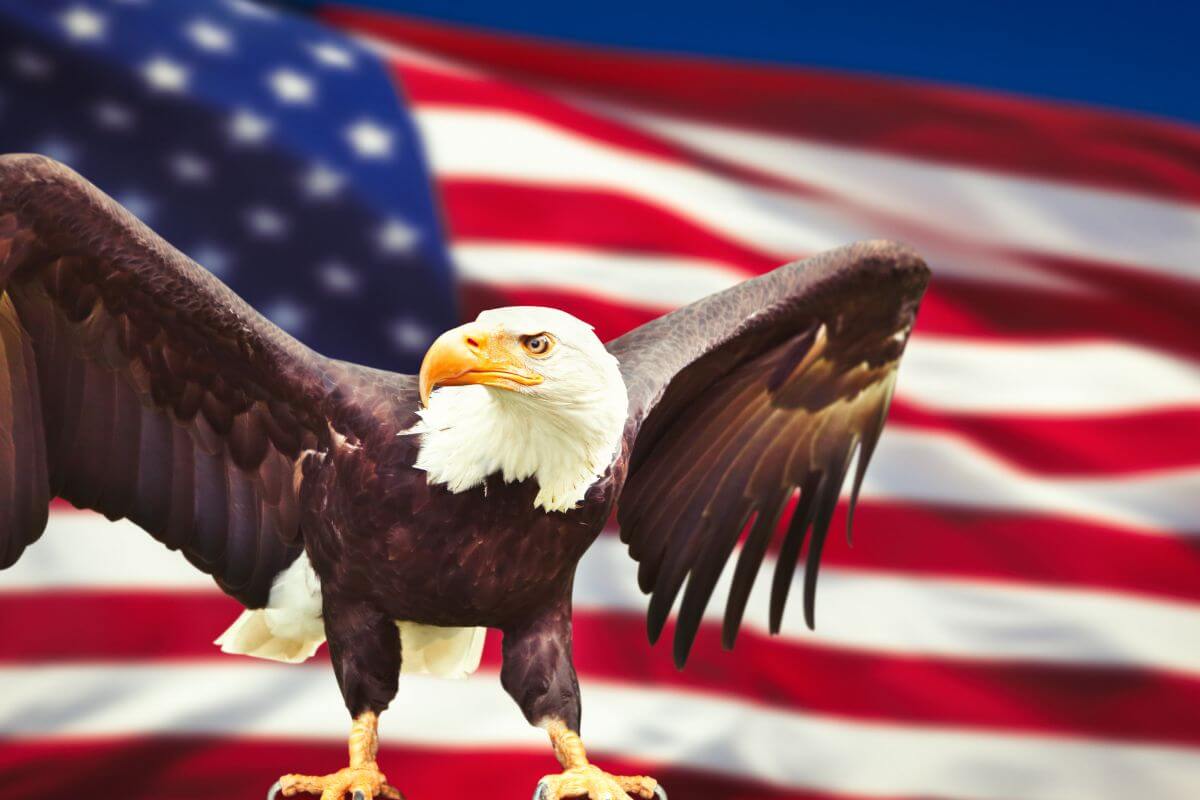
State symbols are more than just mere icons chosen at random. They hold deep meaning and significance for the local people.
They weave together a tapestry of identity, unity, and pride, reminding us of the importance of preserving heritage and celebrating uniqueness, even in the largest city.
But why are these symbols important? Well, they serve as a reminder of the state’s unique identity and help foster a sense of pride and belonging among its residents.
They are a way to celebrate the history, traditions, and natural wonders that make this state truly one-of-a-kind.
Here are some reasons why state symbols are considered significant:
- National Identity – State symbols foster national identity by representing shared heritage and history.
- Patriotism and Unity – They evoke patriotism and unity among citizens, creating a sense of belonging.
- Historical and Cultural Significance – State symbols hold historical and cultural significance, honoring a country’s past.
- International Representation – They represent a nation in international relations, being displayed at diplomatic events.
- Legal and Governmental Use – State symbols are used in official government functions, reinforcing the state’s authority.
- Education and Awareness – They educate and raise awareness, instilling civic responsibility and national pride.
- Tourism and Promotion – State symbols can attract tourists, becoming iconic representations of a country.
- Cultural Diplomacy – They serve as tools of cultural diplomacy, promoting a nation’s values globally.
Montana State Symbols
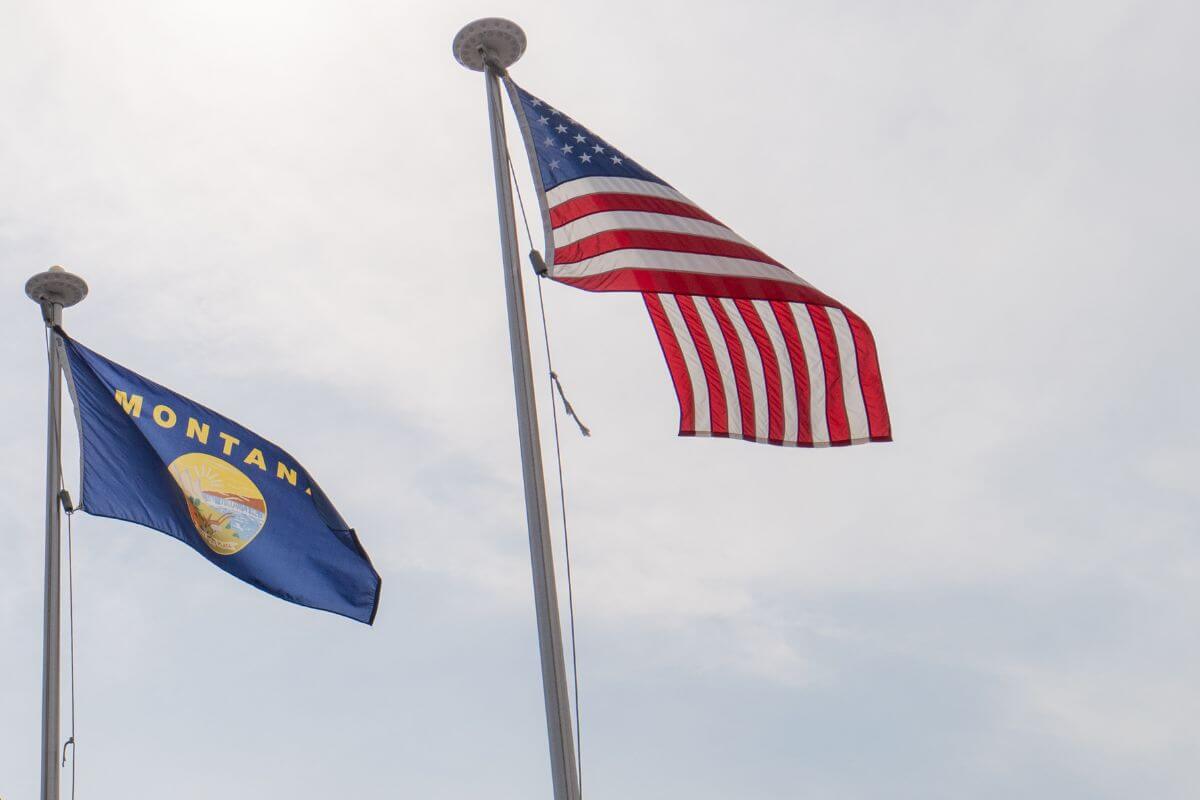
Montana, known for its stunning beauty and history, has numerous state symbols. From the Ponderosa Pine to Glacier National Park’s peaks, each embodies the state’s essence.
These symbols, ranging from the state’s flag to its native wildlife and gemstones, capture the spirit and character of this extraordinary place.
State symbols serve as reminders of Montana’s unique identity and heritage, inviting visitors to discover its natural wonders, embrace its traditions, and forge a deeper connection with the land.
1. Montana State Flag
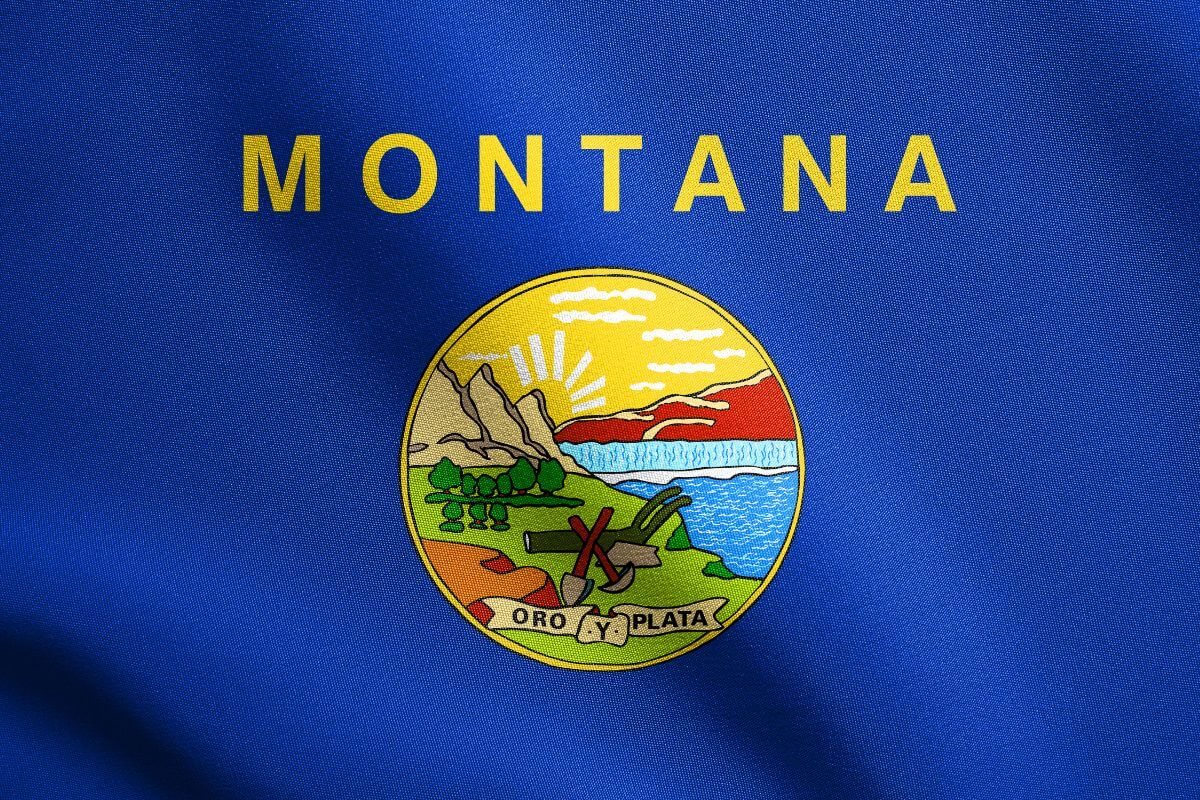
The state flag proudly displays the state’s rich history and breathtaking scenery. In bold, large gold letters, the word “Montana” stretches across the top, drawing attention to the state’s name.
The design of the flag showcases the state’s natural beauty, with a backdrop of majestic mountains, sprawling forests, and the magnificent Great Falls of Missouri.
A brilliant sun rises over these iconic landmarks, symbolizing the bright future and optimism of the people.
Additionally, the golden fringe along the upper and lower borders adds a touch of elegance and sophistication to the flag’s design.
“Oro y Plata,” is prominently featured on the Montana flag’s seal. Translated from Spanish, it means “Gold and Silver.” This pays homage to the state’s rich mining heritage and abundant natural resources.
The state flag’s design has remained consistent over the years, but there have been a few modifications.
The current Montana State Flag was adopted in 1905, and in 1981, the word “Montana” was added above the seal to emphasize the state’s identity.
2. Montana State Seal
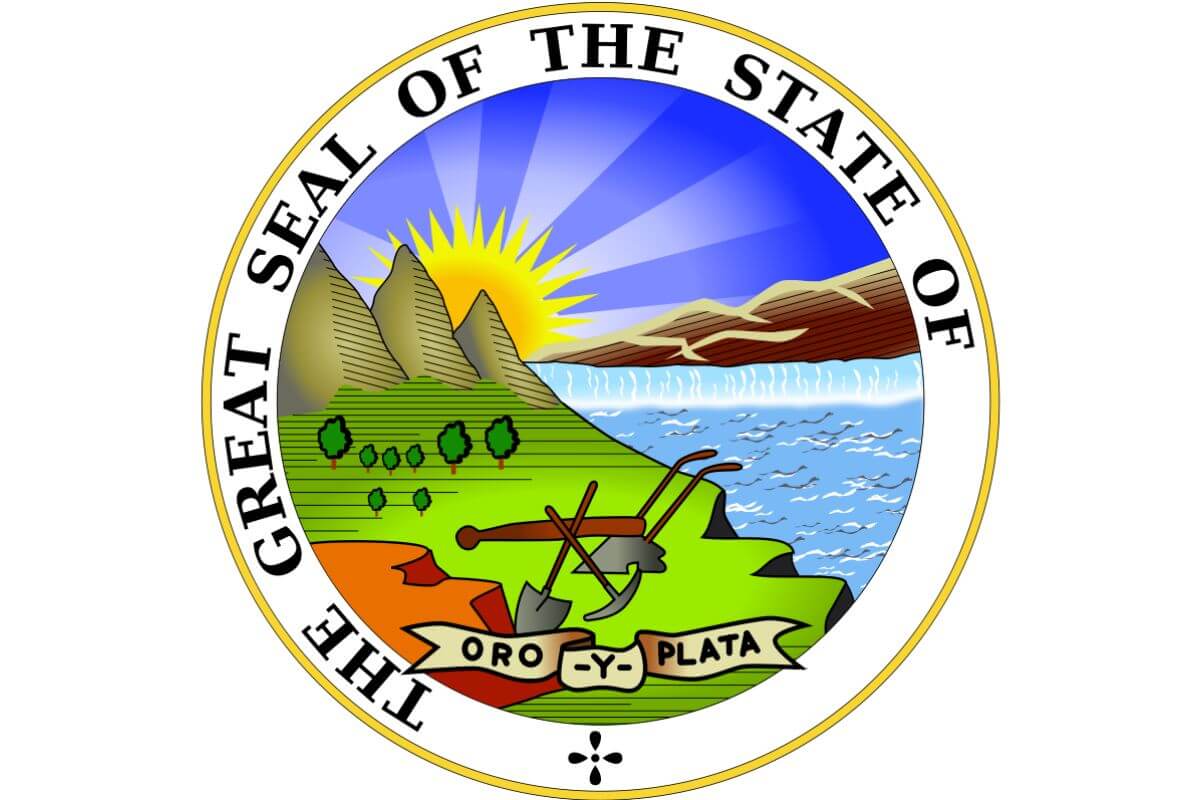
The Montana State Seal, designed in 1865, is a powerful emblem that encapsulates the spirit and essence of this great state.
Crafted by the talented hands of Francis M. Thompson and his committee, the Montana State Seal stands as a testament to the state’s rich history and abundant resources.
Within the seal, one can find a plethora of symbols that represent the state’s mineral wealth and agricultural heritage.
The rays of the sun, bursting forth with vibrant energy, symbolize the bright future. Majestic mountains loom in the background, a nod to the state’s awe-inspiring natural beauty.
Trees, plows, picks, and shovels serve as a reminder of the state’s deep-rooted connection to both its natural resources and its agricultural traditions.
Yet, the seal’s most striking aspect is its motto: “Oro y Plata,” meaning “Gold and Silver” in Spanish. This phrase encapsulates the state’s economic and historical significance of its minerals.
Since its creation, the Seal of Montana has undergone some slight modifications. G.R. Metten took a few liberties, altering the design while preserving its essence.
Yet, the core elements and the spirit of the seal have remained steadfast, proudly representing Montana’s unique character.
3. Montana State Motto: “Oro y Plata”

“Oro y Plata” is a captivating Motto of Montana whispered with a hint of mystery, originates from the Spanish language, adding an air of poetic allure to the region’s identity.
Territorial Governor Sidney Edgerton, both a visionary and a dreamer, infamously signed the bill into law on that fateful winter day of February 9, 1865.
Little did he know that he was immortalizing a phrase that would come to represent the essence of the state itself.
In its simplest translation, “Oro y Plata” means “Gold and Silver.” These precious metals, shimmering wonders hidden deep within Montana wilderness, captivated the hearts and minds of many adventurers.
They bear witness to the wealth beneath rugged terrain, shaping the region’s history and economy. Yet, this motto isn’t merely about minerals, it’s a declaration of the state’s spirit.
It symbolizes the resilience, the hope, and the untapped potential that the state exudes. It is a reminder of the golden opportunities that await, and the silver linings that can be found in even the darkest of times.
4. Montana State Nickname: Treasure State
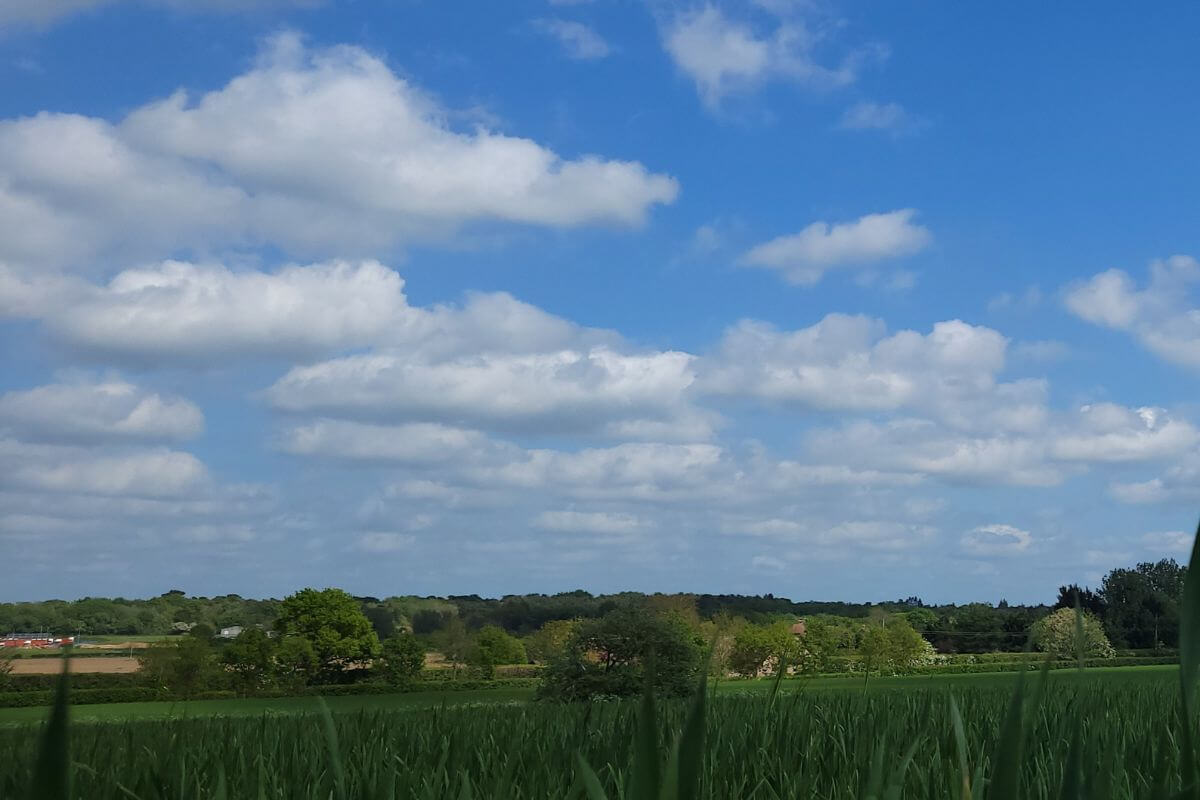
“Treasure State” originated from the plentiful mining activities that took place in Montana during the 1800s. It is a testament to the rich mineral reserves that lie deep within its rugged terrain.
But the state’s treasures extend far beyond its underground wealth. The vast open skies that stretch as far as the eye can see have earned it another moniker: Big Sky Country.
This nickname was popularized by State Highway Department promotion in the 1960s and perfectly captures the grandeur and expansiveness of this magnificent state.
Yet, there is still one more nickname that encapsulates the essence of Montana: The Last Best Place.
Montana the Treasure State, first used by Douglas Chadwick in his book A Beast the Color of Winter, was later popularized by William Kittredge in his book The Last Best Place: A Montana Anthology.
It speaks to the notion that the state is not just a destination, but a sanctuary of beauty, serenity, and unspoiled wilderness.
Other nicknames for Montana are “Bonanza State,” “Land of Shining Mountains,” “Stub-Toe State,” “Headwaters State,” “Mountain State,” “Montana: High, Wide, and Handsome,” “The 406,” and “EZ 2 LUV.”
5. Montana State Song: Montana

The narrative behind the state song of Montana began with a challenge from a former member of Joseph E. Howard’s company, Mrs. E. Creighton Largey, who left the stage to marry a prominent Butte businessman.
Determined to find a musical tribute for her beloved state, Mrs. Largey issued a challenge to composers near and far.
Enter Charles Cohan, a talented songwriter from New York. Inspired by the state’s majestic landscapes and the resilience of its people, Cohan penned lyrics that captured the spirit of the state.
But what good are lyrics without a melody? That’s where Joseph E. Howard, an accomplished composer, came in. Howard crafted Cohan’s words into a song that would deeply move Montanans for generations.
On February 20, 1945, the Montana state song was formally adopted. Through Mrs. Largey’s endeavors and the Cohan-Howard partnership, the state gained an anthem representing its beauty and resilience.
It was a fitting tribute to a state that held so much natural wonder and a people who embodied the pioneering spirit.
6. Montana State Insect: Mourning Cloak Butterfly

The mourning cloak, or Nymphalis antiopa, is the state’s butterfly. This is a creature of great significance, not only as a symbol but also for its role in the local ecosystem.
The mourning cloak butterfly gets its name from its striking resemblance to a traditional dark-colored cloak worn during times of mourning.
Its velvety dark brown wings are adorned with bright blue spots along the inner edge of a distinctive yellow or beige border. This unique coloration makes it easily recognizable and adds to its allure.
One interesting aspect of the mourning cloak’s behavior is its penchant for resting on dark tree bark. This clever choice of resting spot helps the butterfly camouflage itself and blend in.
It also allows them to bask in the glorious rays of the sun, as they open their wings and angle their bodies towards it. By doing so, they can increase their body temperature before taking flight.
In 2001, thanks to the efforts of individuals like James Whitaker who sponsored House Bill No. 365, the mourning cloak butterfly was rightfully designated as the official state insect.
This recognition as the Butterfly of Montana highlights the butterfly’s beauty and importance within the state’s diverse ecosystem.
7. Montana State Bird: Western Meadowlark

To Meriwether Lewis goes the distinction of not only “discovering” the Bitterroot but also first recording what became the state bird, and what a delightful bird it is the western meadowlark.
With its vibrant yellow breast and a distinctive black spot on its throat, the western meadowlark is a true symbol of Montana’s natural beauty.
When Lewis first encountered the western meadowlark, he couldn’t help but be struck by its resemblance to the eastern lark he was more familiar with.
But it was the bird’s enchanting song that truly captured his attention. Richer and more varied than its eastern counterpart, the western meadowlark’s vocal talents are truly a marvel to behold.
In 1931, when the state sought a bird to represent its unique spirit, the choice was clear for the Montana State Bird title. The meadowlark’s physical appearance, habitat, and behavior all aligned with the essence of the state.
8. Montana State Animal: Grizzly Bear
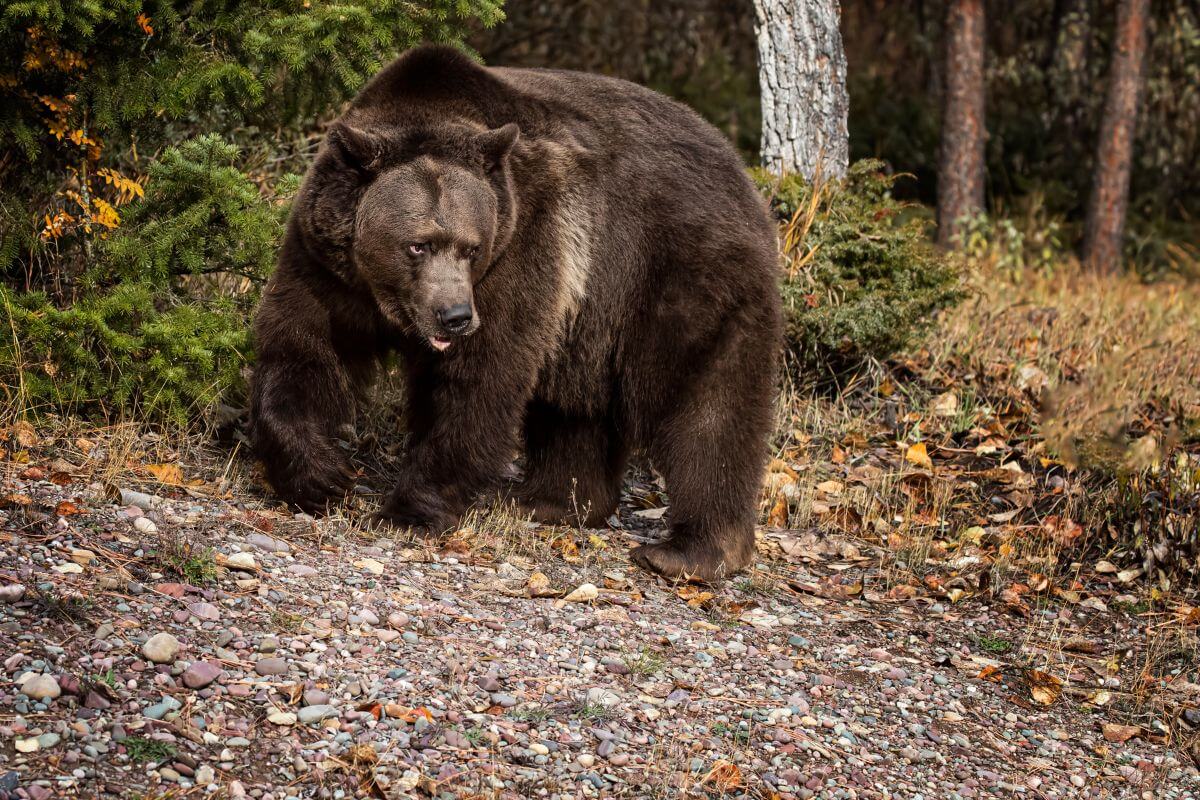
When Secretary of State Jim Waltermire decided to let school children choose the state’s official animal in 1982, they couldn’t have made a more fitting choice.
Grizzly bears, a subspecies of Brown Bear, are an iconic presence in Montana’s rugged landscape and truly embodies the essence of the state.
Only surpassed in size by the Kamchatka brown bears and the Kodiak bears, these magnificent creatures command attention wherever they roam.
But it’s not just their impressive size that captivates. Grizzly bears, with their variable coat colors ranging from blond to nearly black, have fur that is typically brown with darker legs.
Let’s not forget the signature white or blond-tipped fur on the flank and back, adding a touch of elegance to their already majestic appearance.
Habitat-wise, grizzly bears call wilderness their home. From the towering mountains to the sprawling forests, these formidable creatures roam freely, making the most of the state’s diverse terrain.
And when it comes to diet, grizzly bears are opportunistic omnivores, feasting on a wide variety of foods including berries, nuts, roots, fish, and even the occasional small mammal.
But grizzly bears are not just symbols of physical strength and beauty. They hold a deep cultural and historical significance in the state.
On April 7, 1983, Governor Ted Schwinden, donning a grizzly bear cap, signed the Grizzly Bill into law, officially designating the grizzly bear as the Montana State Animal.
While their populations have faced challenges in recent years and conservation efforts are ongoing, the importance of protecting these remarkable creatures cannot be overstated.
9. Montana State Fish: Blackspotted Cutthroat Trout
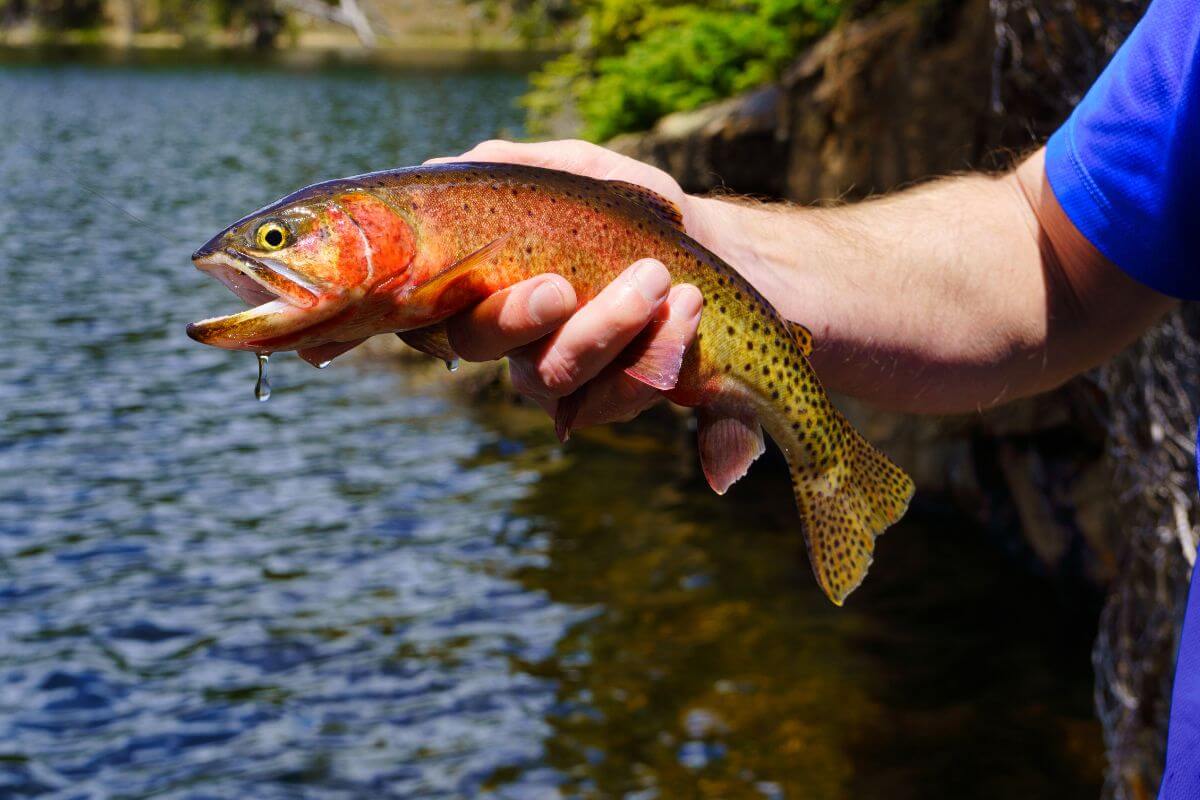
It all started with a simple conversation between Norma Ashby and her husband, Shirley, of Great Falls. They were discussing state symbols and had the brilliant idea to honor the Blackspotted Cutthroat Trout as the Montana State Fish.
The Blackspotted Cutthroat Trout grows to lengths between 6 and 16 inches, these trout are a sight to behold in the pristine waters of Montana’s rivers and lakes.
Their unique coloration sets them apart, with a golden gray-green hue that shimmers in the sunlight. But what truly catches the eye are the black spots that adorn their bodies, scattered like stars in a night sky.
Even more impressive are the sizable, irregular greenish-gray spots on their sides. It’s as though Mother Nature used a paintbrush to enhance these already remarkable creatures with artistic flair.
And let me tell you, seeing a school of Blackspotted Cutthroat Trout swimming together is a sight that will leave you speechless.
On February 10, 1977, Governor Thomas Judge recognized the importance of Blackspotted Cutthroat Trout by signing the law designating it as Montana state fish.
10. Montana State Flower: Bitterroot

The Montana State Flower is the bitterroot, also known as Lewisia rediviva. It’s a perennial wildflower that captivates with its delicate and exquisite pink blossoms.
Picture walking through the vast expanse of wilderness and spotting these little bursts of color near the ground, offering one of the loveliest displays of wildflowers you’ve ever seen.
It’s as if they’re nature’s way of saying, “Look closely and you’ll find beauty in unexpected places.” But the bitterroot is more than just a pretty face.
Bitterroot holds a special place in Montana’s history and culture. After the 1889 Women’s Christian Temperance Union (WCTU) meeting in Missoula, the bitterroot was chosen as the Montana state flower.
Initially, a “little blue flower near snow banks” was favored, but sentiment shifted as the bitterroot’s historical significance became apparent.
Bitterroot is linked to the Lewis and Clark expedition, making it a part of the state’s heritage. Meriwether Lewis himself discovered and documented the plant during the expedition, later named after him.
- Related article: Montana Native Plants
11. Montana State Fruit: Huckleberry
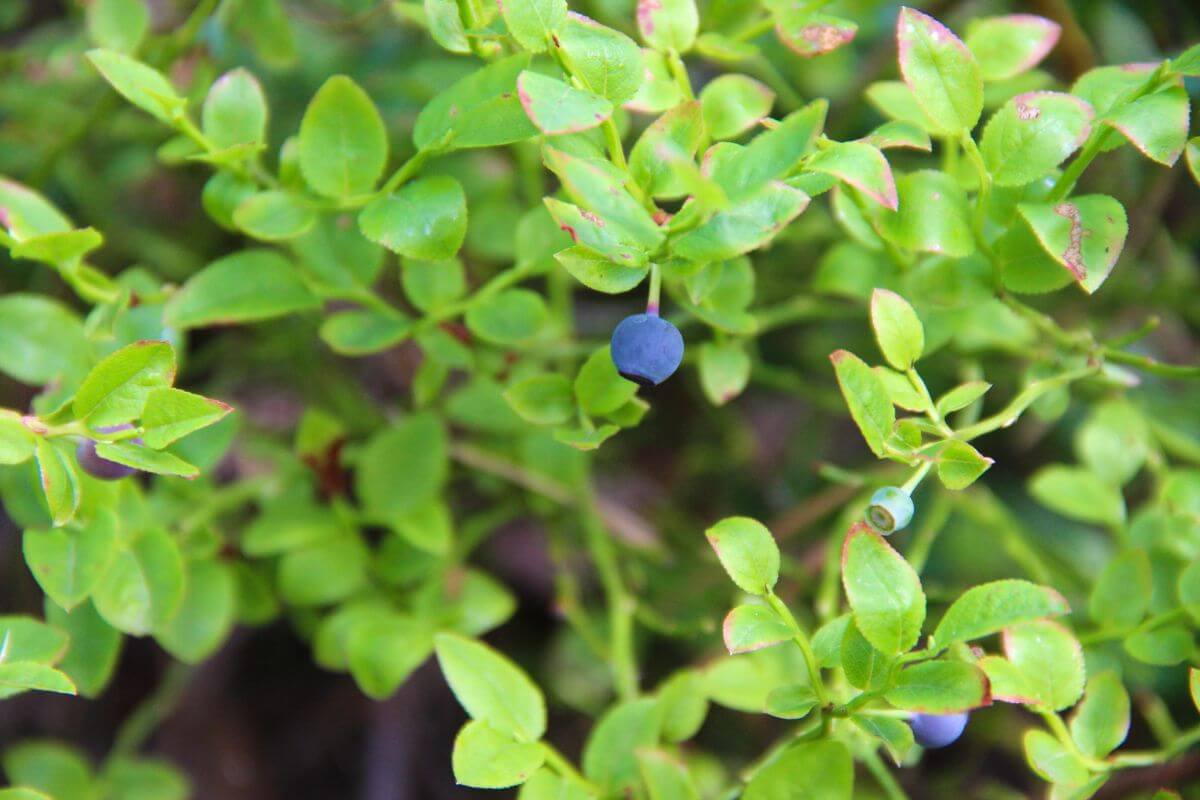
On May 10, 2023, students from Vaughn Elementary School advocated for a bill, leading Governor Gianforte to sign House Bill 880 into law, officially declaring Huckleberry as the Montana State Fruit.
“Whether you like them in jam, pancakes, or picked fresh off the bush, huckleberries are a Montana staple,” Gov. Gianforte said.
“Thanks to the hard work of bright young Montanans at Vaughn Elementary School, the huckleberry is now our official state fruit.”
Let me tell you some fascinating facts about this delectable fruit and how it holds a special place in the state’s culture and history.
Huckleberries are crucial in grizzly bears’ diets. These majestic animals rely on them for 15 to 50% of their food intake due to their strong affinity for these small purple fruits.
In the past, huckleberries were used as a natural substitute for paint, thanks to their rich purple-blue color. They were not just a source of sustenance, but also a tool for artistic expression.
Apart from being delicious, huckleberries are packed with Vitamin C, making them an excellent choice for bolstering the immune system.
The significance of huckleberries extends beyond their culinary uses. Indigenous communities have utilized huckleberries for medicinal purposes for generations.
Both berries and leaves have been employed as remedies for heart problems, arthritis, and rheumatism.
12. Montana State Tree: Ponderosa Pine
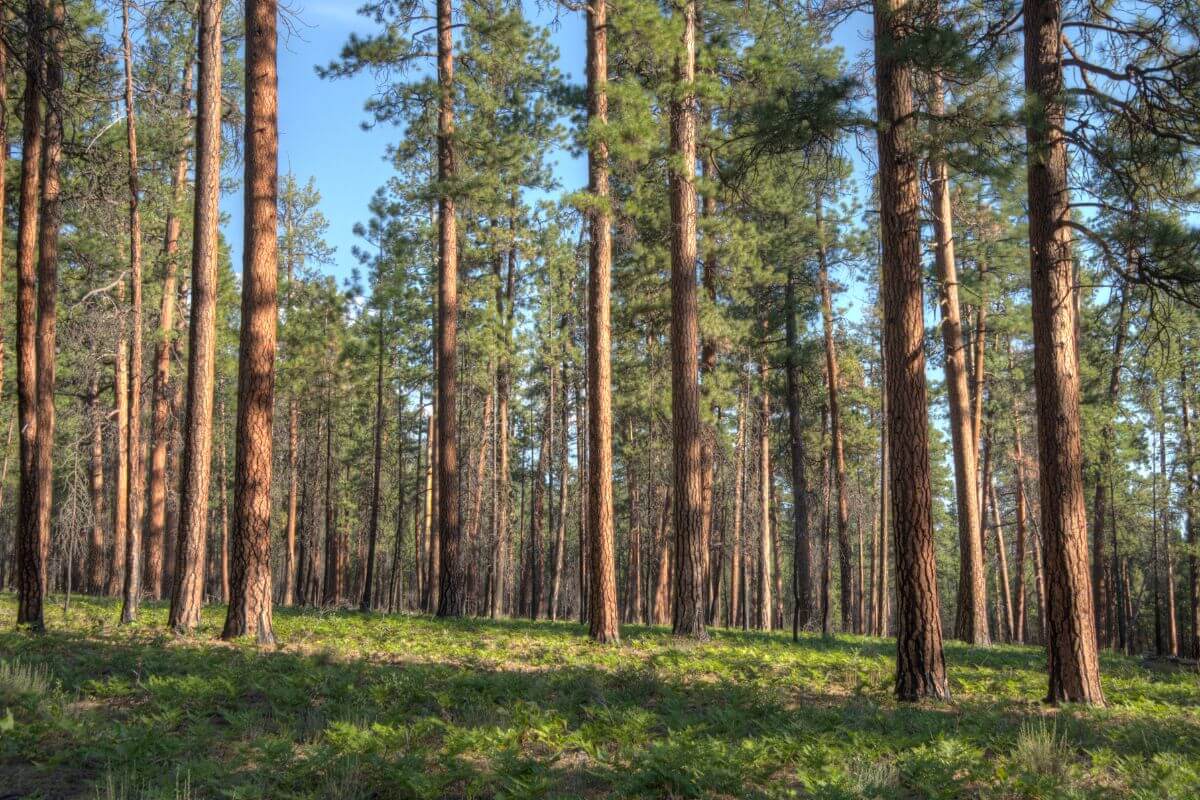
Back in 1908, the schoolchildren of Helena organized a referendum to determine which tree should represent the state.
The Ponderosa Pine emerged as the winner, outshining the fir, larch, and cottonwood for the prestigious Montana State Tree title. It’s no surprise as the tree has captivated hearts and minds with its grandeur for centuries.
In 1949, the legislature took note of the overwhelming support for the tree and officially declared the Ponderosa Pine as the official state tree of Montana.
Various groups, including The Montana Federation of Garden Clubs, championed this cause, recognizing the tree’s economic importance and its deep connection to the state’s natural heritage.
This beloved tree goes by many names, the yellow pine, bull pine, and jack pine, but its true identity lies in its towering presence and distinctive bark.
Its long needles, which come in pairs, and its delightfully fragrant resin make it a sight to behold and a treat for the senses.
And let’s not forget about the seeds within those iconic cones, affectionately known as pine nuts, which have found their way into numerous culinary creations.
13. Montana State Grass: Bluebunch Wheatgrass
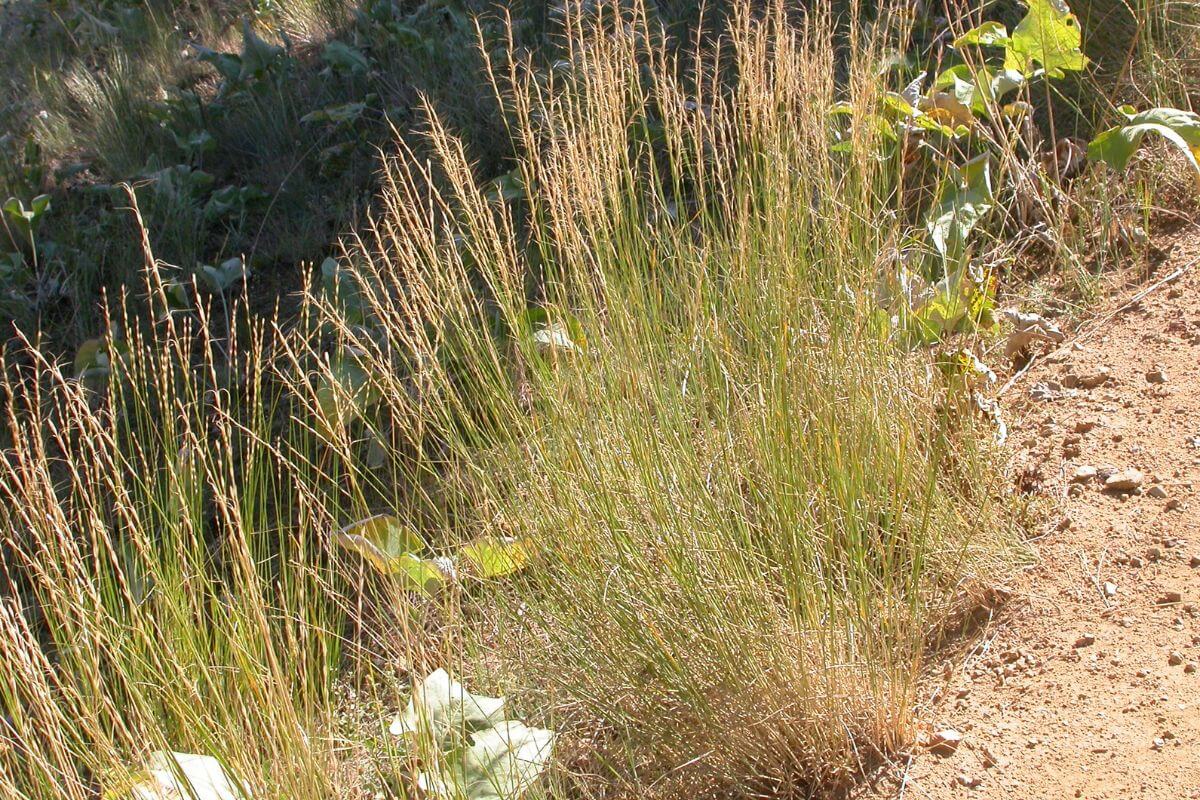
Bluebunch wheatgrass, Montana’s state grass, proudly displays its adaptability to diverse ecological niches with its tall, slender spikes reaching for the sky.
Standing at a height of 1 to 2 ½ feet, this remarkable grass showcases short rhizomes that enable it to thrive in various conditions.
Its growth cycle begins in April, and its green foliage persists well into the summer, rejuvenating after fall rains.
In the spring of 1972, a dedicated group of individuals in Havre, MT, united under the organization forum, sponsored by the local Chamber of Commerce and Hill Country Extension Service.
Their mission was to recognize the state’s natural heritage by selecting an official state grass, and it is here that the idea of bluebunch wheatgrass was conceived.
However, it wasn’t until the 43rd Legislature in 1973 that Senator David James took the lead in advocating for bluebunch wheatgrass to be officially recognized as a Montana State Grass.
Through the passage of Senate Bill 41, this goal was successfully achieved, solidifying bluebunch wheatgrass’s place as an emblem of the state’s rich natural tapestry.
Notably, bluebunch wheatgrass holds the distinction of being not only the official grass of Montana but also the state grass of Washington. This plant has been chosen by not just one, but two states!
With its distinct blue-green color and spike-like seed heads, scientifically known as Pseudoroegneria spicata, it graces the landscapes of both regions, adding visual charm to their surroundings.
Bluebunch wheatgrass’s intrinsic value extends beyond its symbolic significance. This hardy grass is drought-resistant, making it an essential resource for livestock grazing in arid regions.
It also plays a vital role in soil conservation, preventing erosion and promoting ecological stability.
14. Montana State Fossil: Duck-Billed Dinosaur
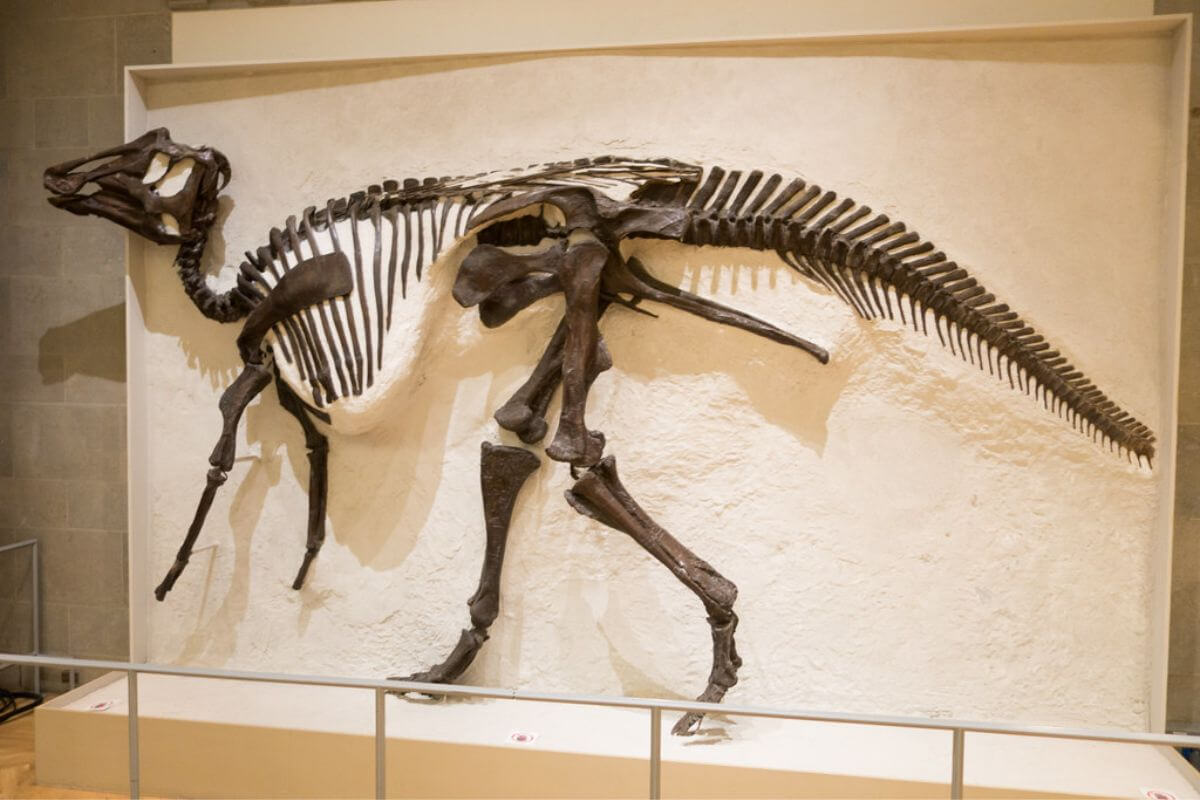
Scientifically named Maiasaura peeblesorum, the Duck-Billed Dinosaur is integral to Montana’s paleontological history, with abundant fossils and insights into the region’s ancient ecosystems.
It started on February 22, 1985, when the state chose to honor this ancient resident. An unexpected group, consisting of middle school students and rock enthusiasts, led the effort to make this decision.
Helmed by Helen Peterson, a 6th-grade teacher from Livingston Middle School, and Ben Veach, the former president of the Montana State Council of Rocks and Minerals. This passionate group championed the cause of recognizing the Duck-billed Dinosaur as an emblem of the state’s prehistoric heritage.
Their efforts proved fruitful, as the legislation, aptly named Bill 130, received unanimous approval from the legislature. On that historic day, the state proudly declared the Duck-billed Dinosaur as its official Montana State Fossil, with Governor Ted Schwinden signing the bill into law.
Maiasaura, which translates to “caring mother lizard” in Greek, roamed the lands of what is now Montana during the Upper Cretaceous Period, around 74 million years ago.
It was a herbivorous dinosaur with a distinctive duck-like bill, lending it its charming nickname.
15. Montana State Gemstone: Sapphire and Montana Moss Agate
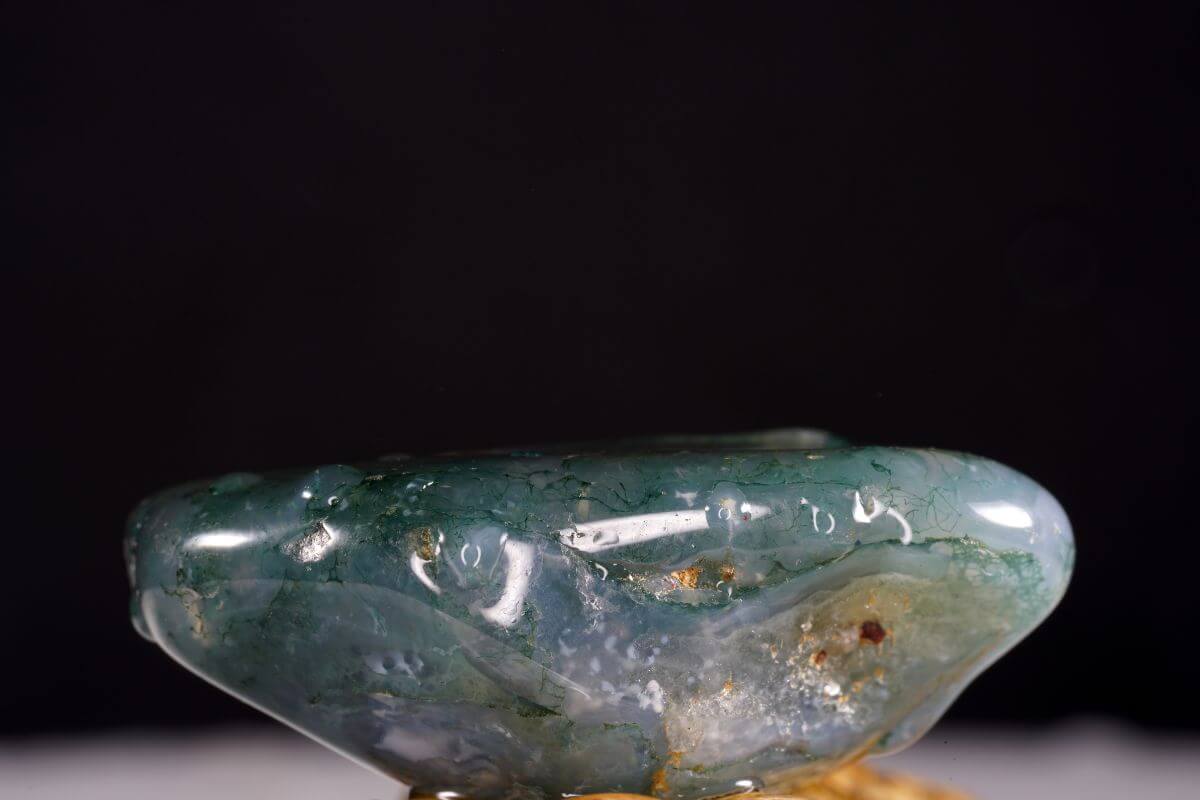
In 1969, the state officially recognized the Montana agate as its Montana State Gemstone, alongside the Sapphire. These stones are abundant along the Yellowstone River in the southern and eastern regions of the state.
The significance of the Sapphire extends beyond its radiant beauty. It plays a crucial role in the state’s economy, attracting gemstone enthusiasts from all over the world.
The Sapphire, once polished to perfection, finds its way into stunning pieces of jewelry that adorn countless wrists, necks, and fingers.
But let’s not forget another gemstone that deserves a shining spotlight: the Montana Moss Agate. This captivating gemstone, often mistaken for a simple rock, holds its own unique allure.
With its opaque white color and mesmerizing patterns of greys and blacks, the Montana Moss Agate is truly a gemstone like no other.
16. Montana State Soil: Scobey Soil
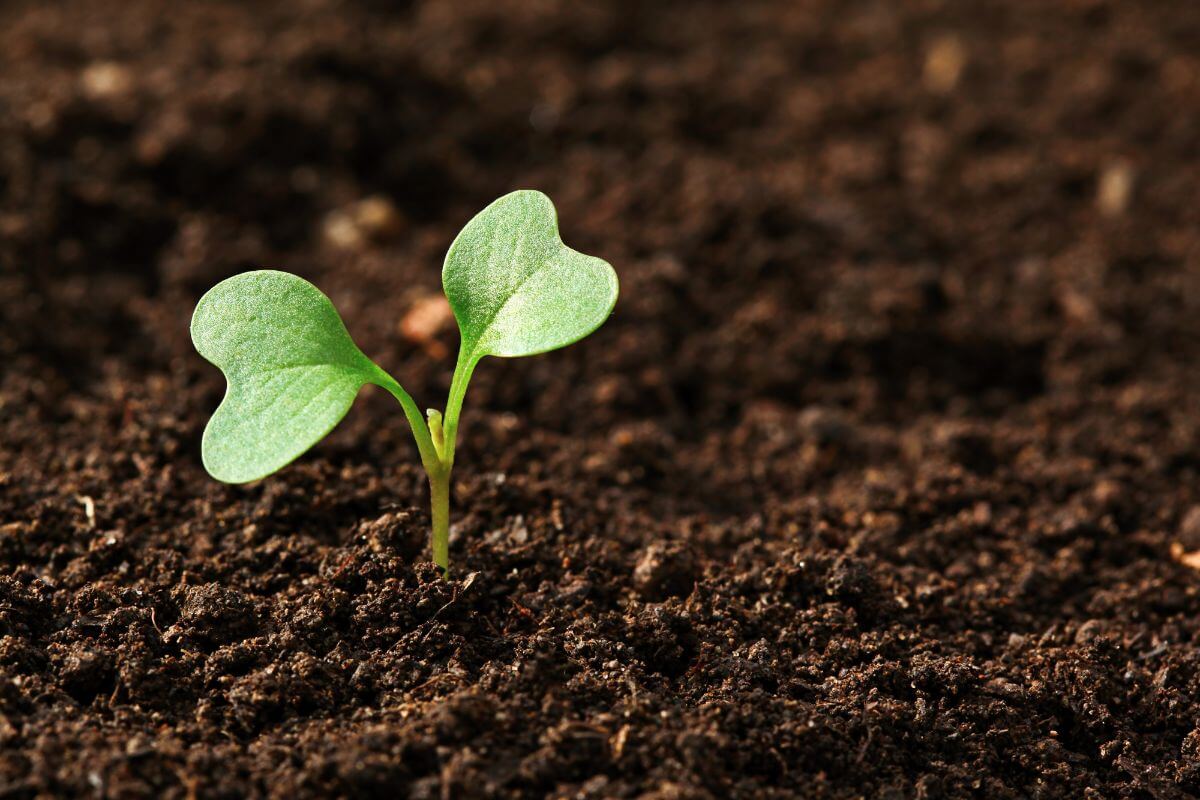
The Scobey soil has been designated as Montana state soil by the National Resources Conservation Service. State soils hold special significance for each state, similar to state flowers and birds.
Covering over 700,000 acres in the north-central part of the state, Scobey soils boast a unique composition that sets them apart from the rest.
With elevated levels of organic matter and clay, these soils have a remarkable ability to retain water, particularly during the wet spring season.
This suits dry-land farming well, forming a vital base for agricultural success. The fertile Scobey soil owes its richness and deep hue to its texture, supporting thriving crops in the region.
Wheat, in particular, holds a special place in the heart of Montana’s agriculture, and the Scobey soil plays a vital role in producing wheat of exceptionally high quality.
The Scobey soil, ranging from golden fields stretching as far as the eye can see to the satisfying taste of freshly baked bread, stands as an indispensable partner in Montana’s economic growth.
Efforts are ongoing to officially recognize Scobey soil as the state soil through legislation. If successful, Montana will join other states in acknowledging soil’s role in shaping identity and growth.
Just as state flowers and birds symbolize the uniqueness of a place, the designation of state soils highlights the integral role that the land plays in the fabric of a state.
17. Montana State Ballad: Montana Melody

In 1983, “Montana Melody” became the official state ballad. It was a moment that celebrated the creative spirit of its people and showcased the deep connection between music and identity.
Montana Melody was the brainchild of LeGrande Harvey and Carleen Harvey, who poured their souls into crafting a melody that captured the essence of the state.
Yet, it wasn’t only the musicians’ talent that breathed life into this ballad. The dedication of Jefferson School students in Helena played a pivotal role in its adoption.
Their unwavering belief in the power of music and their unwavering dedication to making their voices heard culminated in the recognition of “Montana Melody” as an official state symbol.
It was a testament to the profound impact that music can have on our lives and the sense of pride that it can instill in our hearts.
So, let us revel in the beauty of the chorus of “Montana Melody,” a chorus that echoes the sentiments of all those who call Montana home:
“Yes, there’s no place like Montana,
the Big Sky country, my home.
A place to set my spirit free,
a Rocky Mountain melody,
These things are a part of me,
Montana, Montana, my home.”
Read more about Montana Music
Montana State Symbols Final Thoughts
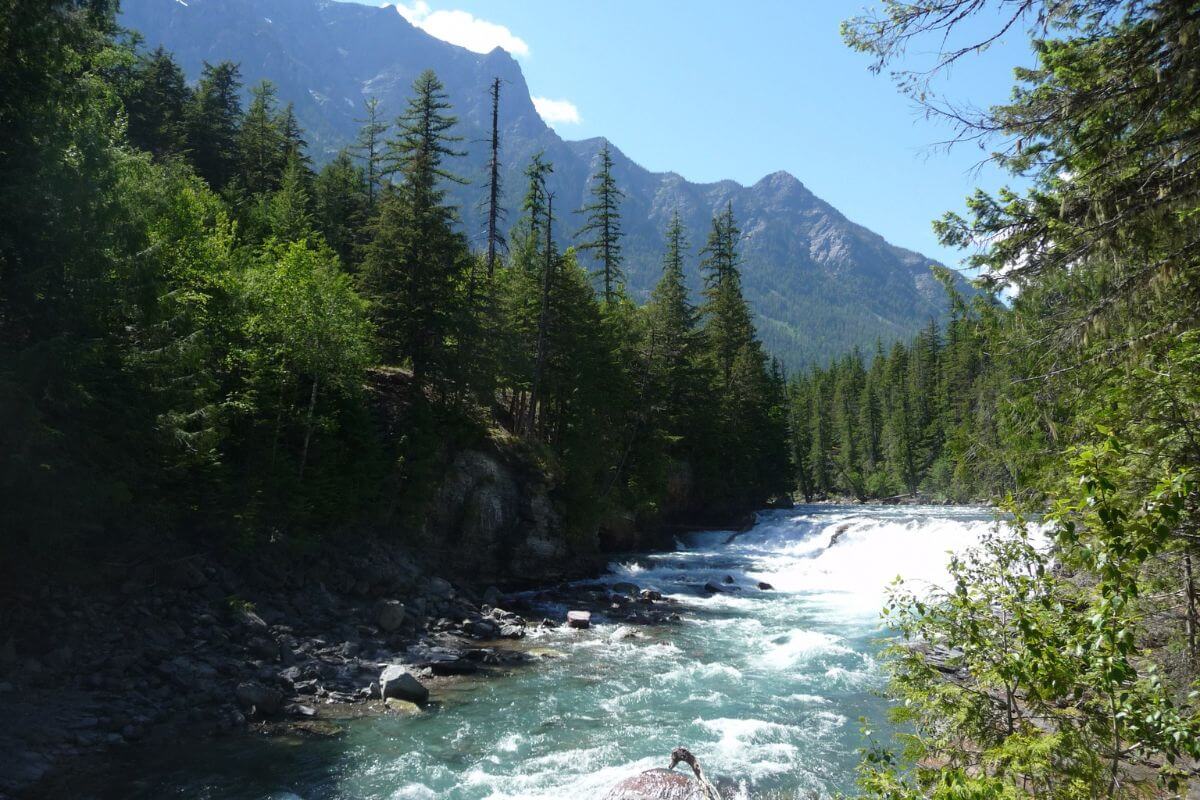
Montana state symbols are more than superficial designations. They hold a deep significance, acting as windows into the past, bridges to the present, and beacons guiding Montana into the future.
The rich history of the Montana State Flag, with its majestic mountains and brilliant sun, serves as a reminder of the state’s bright future and enduring optimism.
The Montana State Motto, “Oro y Plata,” echoes the spirit of untapped potential and the precious resources that have shaped the state’s identity.
The state’s creatures, like the Grizzly Bear and the Western Meadowlark, not only showcase Montana’s diverse ecosystems but also embody its strength, beauty, and resilience.
From the State Flower, the Bitterroot, to the State Tree, the Ponderosa Pine, each symbol captures the essence of Montana’s landscapes, from wildflowers to towering trees that define its wilderness.
By acknowledging the Montana state fossil, the Duck-Billed Dinosaur, and the state gemstones, the Sapphire and Montana Moss Agate, we explore the state’s history and its hidden natural treasures.
And amidst all this, we find a melody, “Montana Melody,” that unites the people with the land, celebrating the creative spirit that thrives in this state.
These symbols are a testament to the people who cherish and steward the land, carrying forward a legacy of respect for nature’s bounty.
They are a reflection of the vibrant communities that embrace Montana’s identity, embodying a spirit of unity and shared purpose.
Montana’s state symbols are more than static representations; they are living embodiments of the stories and values that resonate within its boundaries.
As we grasp the importance of each symbol, we’re reminded that they come together to create Montana’s distinctive melody, echoing through its landscapes, mountains, and prairies, capturing its heart and soul.
To quench your fascination with Montana and gain deeper insights, stay connected and explore these captivating articles:
- https://leg.mt.gov/bills/mca/title_0010/chapter_0010/part_0050/section_0050/0010-0010-0050-0050.html
- http://plainshumanities.unl.edu/encyclopedia/doc/egp.ii.054
- https://mhs.mt.gov/education/docs/Footlocker/Symbols.pdf
- https://leg.mt.gov/bills/mca/title_0010/chapter_0010/part_0050/section_0080/0010-0010-0050-0080.html
- https://leg.mt.gov/bills/mca/title_0010/chapter_0010/part_0050/sections_index.html
- https://leg.mt.gov/bills/mca/title_0010/chapter_0010/part_0050/section_0040/0010-0010-0050-0040.html
- https://fwp.mt.gov/binaries/content/assets/fwp/montana-outdoors/2011/statesymbols.pdf
- https://guides.lib.montana.edu/soilsurveys
- https://news.mt.gov/Governors-Office/Governor_Gianforte_Joins_Students_To_Designate_Huckleberry_as_State_Fruit
- https://commons.wikimedia.org/wiki/File:Pseudoroegneria_spicata_(3817076915).jpg
- https://www.flickr.com/photos/quinet/38991077340

